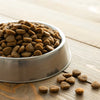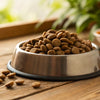Can You Give Dry Cat Food to Dogs? Understanding the Risks and Nutritional Needs
- Houndsy
Table of Contents
- Introduction
- The Nutritional Differences Between Dog and Cat Food
- Potential Risks of Feeding Dry Cat Food to Dogs
- What to Do If Your Dog Eats Cat Food
- Managing a Multi-Pet Household
- Conclusion
Introduction
Did you know that nearly 70% of households in the U.S. own a pet, and many of those have both dogs and cats? This multi-pet dynamic often leads to curious canines sneaking bites from their feline friends' bowls. As pet lovers, we might find ourselves asking: Can you give dry cat food to dogs? The answer isn't as simple as a yes or no. While many pet owners may have witnessed their dogs happily munching on cat food, it’s crucial to understand the implications of this behavior.
In this comprehensive guide, we will delve into the nutritional differences between dog and cat food, the potential risks of feeding dry cat food to dogs, and tips on managing a multi-pet household with distinct dietary needs. By the end of this article, you will have a clearer understanding of how to keep your dog healthy while navigating the complexities of feeding in a shared pet environment.
Let’s explore this topic together and reflect on our own feeding routines. Are we providing the best nutrition for our furry companions?
The Nutritional Differences Between Dog and Cat Food
To answer the question of whether you can give dry cat food to dogs, we first need to understand the significant differences in nutritional requirements for each species.
1. Protein and Fat Content
Cats are obligate carnivores, meaning their diets are primarily composed of meat. As a result, cat food typically contains 26% protein and 9% fat, compared to dog food, which consists of about 18% protein and 5.5% fat according to the Association of American Feed Control Officials (AAFCO). This disparity is important because:
- Higher Protein Needs: Cats require a higher protein intake to meet their energy and metabolic needs, which is why cat food is often richer in meat-based ingredients.
- Fat Levels: The increased fat content in cat food can lead to weight gain and other health issues in dogs if consumed regularly.
2. Essential Nutrients
Beyond just protein and fat, the essential nutrient requirements for dogs and cats differ significantly:
- Taurine: While cats need taurine (a vital amino acid for heart and eye health), dogs do not have this same requirement. Cat food is fortified with taurine, leading to an imbalance when consumed by dogs.
- Vitamins and Minerals: Dogs and cats also vary in their vitamin and mineral needs. For example, dogs require adequate levels of Vitamin A, while cats obtain it through animal proteins.
Summary of Nutritional Differences
| Nutrient | Dogs (AAFCO Minimum) | Cats (AAFCO Minimum) |
|---|---|---|
| Protein | 18% | 26% |
| Fat | 5.5% | 9% |
| Taurine | 0 | 0.1% (dry food) |
| Vitamin A | 5,000 IU/kg | 3,332 IU/kg |
| Arachidonic Acid | 0 | 0.02% |
Understanding these differences is crucial for ensuring that our pets receive the appropriate nutrition. Feeding dogs dry cat food on a regular basis can lead to serious health issues.
Potential Risks of Feeding Dry Cat Food to Dogs
While an occasional nibble of cat food may not cause immediate harm, making it a regular part of a dog's diet can lead to various health complications.
1. Gastrointestinal Upset
One of the most common side effects of dogs consuming cat food is gastrointestinal discomfort. Symptoms can include:
- Vomiting
- Diarrhea
- Abdominal pain
These issues arise primarily due to the high protein and fat content in cat food, which can be difficult for a dog's digestive system to process.
2. Weight Gain and Obesity
The higher caloric density of cat food can contribute to weight gain in dogs, particularly if they are already prone to obesity.
- Caloric Surplus: Regular consumption of cat food can lead to overeating, which means that even a small amount can lead to significant weight gain over time.
- Health Implications: Obesity in dogs can lead to serious health issues, such as diabetes, joint problems, and heart disease.
3. Pancreatitis
Pancreatitis, an inflammation of the pancreas, is another serious risk associated with dogs eating high-fat foods like cat food.
- Symptoms of Pancreatitis: If a dog consumes a large amount of cat food, they may show symptoms such as lethargy, vomiting, loss of appetite, and abdominal pain. This condition requires immediate veterinary attention.
4. Nutritional Imbalance
Feeding dry cat food to dogs can result in nutritional imbalances over time.
- Deficiency in Essential Nutrients: Dogs may develop deficiencies in essential nutrients that are not present in sufficient quantities in cat food, leading to long-term health issues.
- Increased Risk of Chronic Conditions: Prolonged exposure to inappropriate diets can lead to chronic health conditions, including kidney disease and liver issues.
What to Do If Your Dog Eats Cat Food
If your dog has sneaked a few bites of cat food, don’t panic. Here’s a step-by-step guide on how to handle the situation:
1. Monitor Your Dog
Keep an eye on your dog for any signs of discomfort or illness. Symptoms to watch for include:
- Vomiting
- Diarrhea
- Changes in appetite
- Lethargy
2. Contact Your Veterinarian
If your dog eats a significant amount of cat food or shows any concerning symptoms, it’s wise to consult with a veterinarian. They can provide guidance based on your dog's specific health needs.
3. Reassess Feeding Practices
Reflect on your feeding routine and consider implementing changes to prevent future incidents.
- Separate Feeding Areas: If possible, feed your pets in separate rooms or at different times to minimize the chances of your dog accessing cat food.
- Elevated Feeding Stations: Consider using elevated feeding stations for your cat, making it harder for your dog to reach the food.
Managing a Multi-Pet Household
For those of us who share our homes with both cats and dogs, managing their feeding habits can be a challenge. Here are some practical tips to help ensure both pets receive the proper nutrition:
1. Provide Species-Specific Diets
Make sure to feed your pets food that is specifically formulated for their species. This is vital for their health and well-being.
- Quality Dog Food: Invest in high-quality dog food that meets the nutritional guidelines set forth by AAFCO. Options like Houndsy Kibble Dispenser can ensure portion control and reduce mess during feeding.
2. Create Safe Feeding Spaces
Develop designated feeding areas for your pets to avoid food theft:
- Separate Rooms: If you have the space, consider feeding your pets in different rooms.
- Use Barriers: Baby gates or playpens can help keep your dog away from the cat’s food.
3. Train Your Dog
Training can go a long way in managing your dog’s behavior around cat food:
- Commands and Rewards: Teach your dog commands like "leave it" or "no" to discourage them from stealing cat food. Reward them for obeying to reinforce positive behavior.
4. Consider Automatic Feeders
Automatic feeders can help manage your pets' feeding schedules and portions, ensuring each pet receives their food without interference from the other.
5. Regular Vet Check-Ups
Regular veterinary check-ups can help monitor each pet's health and address any dietary concerns proactively.
Conclusion
While it may be tempting to let our dogs indulge in the occasional bite of cat food, the nutritional differences and potential health risks highlight that this should not become a regular practice. Dogs thrive on diets specifically formulated for their needs, and keeping them healthy and happy requires thoughtful feeding strategies.
As responsible pet owners, we must ensure that our furry companions receive the right nutrition. If you’re looking for a convenient and reliable way to feed your dog, consider the Houndsy Kibble Dispenser, designed for both functionality and style. It elevates the feeding experience, ensuring perfect portions every time while blending seamlessly with your home décor.
FAQs
Can dogs eat cat food occasionally? Yes, a small amount of cat food may not harm most dogs, but it should not be a regular part of their diet.
What should I do if my dog eats a lot of cat food? Monitor your dog for any signs of illness and consult with your veterinarian if symptoms arise.
Is cat food harmful to dogs? Cat food is not toxic to dogs, but it is not nutritionally balanced for them and can lead to health issues if consumed regularly.
How can I prevent my dog from eating my cat's food? Feed your pets in separate areas, elevate the cat's food, and train your dog not to approach the cat's bowl.
Can dogs survive on cat food? While dogs can survive on cat food in a pinch, it is not appropriate for their long-term diet and can lead to various health problems.
By understanding these important aspects of pet nutrition, we can better care for our furry family members and enhance their feeding experience. Let's embrace our role as responsible pet parents and ensure our pets live their best lives!












